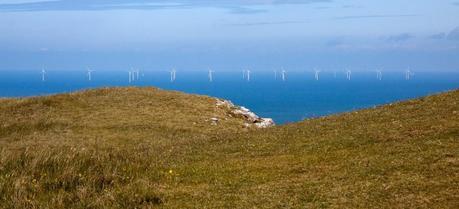 RWE npower renewables’ North Hoyle offshore wind farm viewed from the Great Orme’s Head. The project is located 4-5 miles off the North Wales coast. (Credit: Flickr @ Ingy The Wingy http://www.flickr.com/photos/ingythewingy/)
RWE npower renewables’ North Hoyle offshore wind farm viewed from the Great Orme’s Head. The project is located 4-5 miles off the North Wales coast. (Credit: Flickr @ Ingy The Wingy http://www.flickr.com/photos/ingythewingy/)A study commissioned by the German Offshore Wind Energy Foundation together with RWE Innogy (a renewable energy company is a subsidiary of a German electric utilities company RWE AG) and other companies and associations of the offshore wind industry arrived at the conclusion that the cost of electricity from offshore wind power can be reduced by about one third if offshore wind power is consistently developed over the next ten years.
“The identified cost reduction potentials are based on the assumption that offshore wind power will be continuously developed and reach a capacity of 9 Gigawatt or more by the year 2023. This is the way to gain project experience, to promote technological innovation and to significantly decrease costs,” said Jens Eckhoff, President of the Foundation “Offshore-WindEnergie”, at the presentation of the study in Berlin. Eckhoff continued: “Offshore wind power has a substantial cost reduction potential. However, the industry can only exploit this potential if there are reliable framework conditions to achieve significant market volumes.” The study was commissioned by the German Offshore Wind Energy Foundation, Stiftung “Offshore-WindEnergie”, together with associations and companies of the offshore wind industry.
The study analyses the expected cost development of electricity generation from offshore wind power until the year 2023. For this purpose, two development scenarios were applied to evaluate three typical German sites for offshore wind farms. The first scenario assumes a stable market development and describes the development of at least 9 GW installed capacity in Germany by the year 2023. In this scenario, the cost of offshore wind power decreases on average by about 31 percent across all sites until 2023. The second scenario assumes an optimum market environment with a development of 14 GW until 2023. In this case, costs could decrease by up to 39 percent.
“The main driver for the cost reduction is a continuous technological development across the entire value-added chain. Particularly regarding investment costs, substantial savings can be achieved. Costs for support structures and other components as well as for the installation go down. Larger turbines reduce specific investment costs as the energy yield substantially increases,” said Frank Peter of Prognos AG, co-author of the study.
The study also shows that due to increasing experience in project planning, plant construction and operation, the risks — and subsequently the financing costs — can be reduced. In addition, improved logistics, such as the use of more powerful ships and an optimised infrastructure, can positively affect the costs of offshore plant operation and maintenance. The analysis also shows that in an optimum market environment an expanded serial production and increasing competition will contribute to cost reduction.
Eckhoff explained: “In Germany, we have a number of projects ready and waiting. Currently they lack the required investment security. In order to be able to use the experience gained from the first German offshore wind farms and to promote the further development of the industry, a timely implementation of these projects is necessary. This way offshore wind energy can make an essential contribution to tomorrow’s energy supply.”

